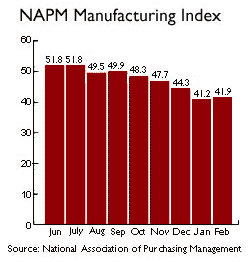|
Manufacturing still slow
|
 |
March 1, 2001: 12:23 p.m. ET
Separate report shows U.S. spending, personal incomes rise
|
NEW YORK (CNNfn) - U.S. purchasing managers reported Thursday that manufacturing activity slowed for the seventh consecutive month in February, but suggested there are signs that the worst may be over. Separately, the government reported increases in consumer spending, personal incomes and construction spending in January.
The data paint a mixed picture of the country's economic health. The reading on the National Association of Purchasing Management index suggests that manufacturing still is in a severe slump, but a slight increase in the index and several of its components appear to bolster Fed Chairman Alan Greenspan's view that the sharp economic downturn at the end of 2000 "seemed less evident" in" in January and February.
In another report, the government said new jobless claims jumped to 372,000 last week, well above forecasts and the previous week's reading, indicating the labor market continued to soften.
Investors, weary from another round of corporate profit warnings, interpreted the economic data as further signs of weakness for the world's largest economy. Wall Street also is growing doubtful that the Fed will deliver another surprise interest rate cut, as widely hoped.
The Dow industrials fell 45 points to 10,450, adding to Wednesday's losses, while the Nasdaq composite recovered late in the session to close up 31 points at 2,182. The bond market gained.
 "Economic conditions look pretty grave right now," said David Resler, chief economist at Nomura Securities. "Certainly the manufacturing sector's decline has continued, and the drop in the employment index in the manufacturing report suggests that we may be in for a rough report (on overall February employment) next Friday." "Economic conditions look pretty grave right now," said David Resler, chief economist at Nomura Securities. "Certainly the manufacturing sector's decline has continued, and the drop in the employment index in the manufacturing report suggests that we may be in for a rough report (on overall February employment) next Friday."
The NAPM index of business activity edged up to 41.9 last month after a reading of 41.2 in January, signaling that manufacturing is declining at a slower rate than in recent months. The reading was roughly in line with analysts' forecasts.
However, the business group says manufacturing is still at levels consistent with an overall recession. A reading below 50 signals that the manufacturing sector is shrinking. The January figure showed manufacturing at its lowest level since early 1991.
The index's employment component plunged to 37.2 in February, from 42 in January.
"The overall picture is one of continued decline in manufacturing activity during the month of February," said Norbert J. Ore, chairman of the group's survey committee. "The manufacturing sector definitely lacks momentum."
But, he said, there are some signs that the manufacturing downturn has bottomed out.
He said "this could be an indication that the manufacturing sector bottomed in January," noting that the new orders component showed a slower rate of decline. However, he said, "we must caution that it takes more than one month's data to make that determination."
Spending, incomes rise
Meanwhile, the Commerce Department said consumer spending and personal incomes rose in January, while construction spending – which has bucked the trend of the slumping economy -- posted its biggest increase in 10 months, rising 1.5 percent in January to a seasonally adjusted annual rate of $830.5 billion, a record monthly level.
Consumer spending, which accounts for about two-thirds of U.S. economic activity, rose 0.7 percent to $6.96 trillion in January, after a 0.4 percent increase in December, the Commerce Department said. Americans' incomes rose 0.6 percent to $8.5 trillion, after a revised 0.4 percent increase in the previous month.
The increases were the biggest since September, when income rose by 1.1 percent and spending grew by 0.8 percent. January's performance was largely in line with analysts' expectations.
But the personal savings rate, savings as a percentage of after-tax income, hit negative 1 percent, the lowest rate on record, compared with negative 0.8 percent in December. However, analysts say the savings rate doesn't provide a complete picture of household finances because it doesn't capture gains realized from things such as higher real-estate values or from financial investments.
Americans' incomes were affected by a number of special factors in January. Cost-of-living adjustments to federal transfer payment programs and pay raises for federal employees and military personnel boosted overall income, while less generous federal payments to farmers subtracted from it.
Excluding those special factors, the government said, incomes rose 0.5 percent in January.
The Federal Reserve is closing watching consumer confidence and spending as it assesses whether the economy is falling into a recession. In testimony Wednesday, Greenspan said that sharp declines in consumer confidence over the past several months have not been accompanied by a sharp drop in spending, providing some hope the United States can avoid a protracted recession.
The latest spending data show that some segments of the economy remain healthy, analysts said.
"It's a darn good start to the first quarter," Tim Rogers, chief economist at Briefing.com, told CNNfn's Before Hours.
However, other analysts note that when adjusted for inflation, spending only rose a mere 0.2 percent in January, following a similar gain in December. There are signs that inflation is beginning to pick up in the economy. The government reported last week that the January consumer price index, the most closely watched U.S. inflation gauge, rose at its fastest pace in 10 months.
"If real spending rises at this pace in February and March, consumer spending will rise just 2.3 percent for the quarter, the softest since Q2 1997," said Ian Shepherdson, chief U.S. economist at High Frequency Economics. 
-- from staff and wire reports
|
|
|
|
|
 |

|

